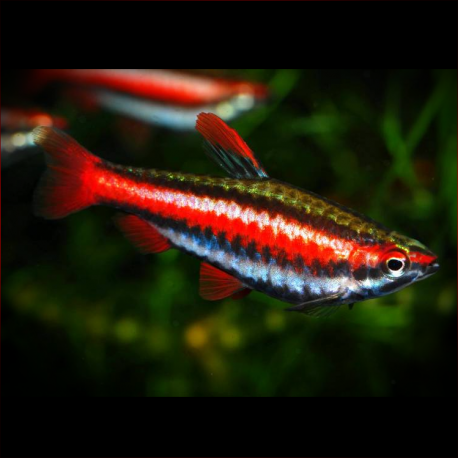More info
Datasheet
| Minimum Tank Size | 80 litres / 21.13 US gallons |
| Maximum Size | 3.0cm / 1.18inches |
| Temperature | 24°C / 75.20°F - 28°C / 82.40°F |
| Hardness | 1.01dgH / 18ppm - 5.04dgH / 90ppm |
| pH | 4.0-7.0 |
General Description
The Nannostomus Mortenthaleri, commonly known as the Coral Red Pencilfish, is a micropredator that feeds on tiny invertebrates and zooplankton in its natural habitat. This species, part of the Lebiasinidae family in the Characiformes order, is characterized by its small size, elongated body shape, and vivid red pigmentation in adult males between the central and upper dark lateral stripes.
Aquarium Setup
The Coral Red Pencilfish thrives in a heavily planted aquarium with a dark substrate, providing broken lines of sight, floating plants, driftwood branches, and dried leaf litter. The tank should have gentle filtration and stable water conditions within a temperature range of 24-28°C, pH of 4.0-7.0, and hardness of 18-90ppm. A minimum tank size of 80 litres is recommended for maintaining this species.
Behaviour
This species exhibits peaceful behavior with other tank mates but should ideally be kept alone or with diminutive, non-aggressive characids and smaller catfish species. While gregarious, they are shoaling species and display territorial behavior among rival males during daylight hours. In confined spaces, aggression can lead to injuries or fatalities, necessitating a spacious aquarium with ample hiding spots for each individual.
Feeding and Diet
Being micropredators, Coral Red Pencilfish feed on tiny invertebrates and zooplankton. In captivity, they accept dried foods of a suitable size but should be offered regular meals of small live and frozen fare like Artemia nauplii, Moina, and grindal worms to maintain their health and vibrancy.
Reproduction & Dimorphism
Reproduction in aquariums is possible but relatively rare. Fry may appear in a densely planted, mature aquarium without intervention, but a more controlled approach can increase the yield of fry. Adult males exhibit brighter colors and a unique white marking at the anterior dorsal-fin base, making them easily distinguishable from females.
Habitat and Distribution
The species is endemic to the Nanay basin in Loreto Department, Peru, along with the Río Tigre system. They inhabit sluggish tributaries, small rivers, and swampy areas with dense aquatic vegetation, submerged woody structures, and leaf litter. These regions typically have low conductivity, very little hardness, and acidic pH levels, creating an environment suitable for small characids, lebiasinids, and dwarf cichlids.

